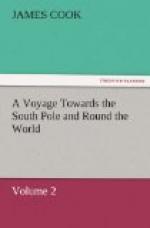These islanders seemed to be a different race from those of Mallicollo; and spoke a different language. They are of the middle size, have a good shape, and tolerable features. Their colour is very dark, and they paint their faces, some with black, and others with red pigment. Their hair is very curly and crisp, and somewhat woolly. I saw a few women, and I thought them ugly; they wore a kind of petticoat made of palm-leaves, or some plant like it. But the men, like those of Mallicollo, were in a manner naked; having only the belt about the waist, and the piece of cloth, or leaf, used as a wrapper*. I saw no canoes with these people, nor were any seen in any part of this island. They live in houses covered with thatch, and their plantations are laid out by a line, and fenced round.
[* The particular manner of applying the wrapper may be seen in Wafer’s voyage, who mentions this singular custom as existing, though with some little variation, amongst the Indians of the Isthmus of Darien. See Wafer’s Voyage, p. 140.]
At two o’clock in the afternoon, we were clear of the bay, bore up round the head, and steered S.S.E. for the south end of the island, having a fine breeze at N.W. On the S.W. side of the head is a pretty deep bay, which seemed to run in behind the one on the N.W. side. Its shores are low, and the adjacent lands appeared very fertile. It is exposed to the S.E. winds; for which reason, until it be better known, the N.W. bay is preferable, because it is sheltered from the reigning winds; and the winds to which it is open, viz. from N.W. by N. to E. by N., seldom blow strong. The promontory, or peninsula, which disjoins these two bays, I named Traitor’s Head, from the treacherous behaviour of its inhabitants. It is the N.E. point of the island, situated in the latitude 18 deg. 43’ S. longitude 169 deg. ‘28’ E., and terminates in a saddle-hill which is of height sufficient to be seen sixteen or eighteen leagues. As we advanced to S.S.E., the new island, we had before discovered, began to appear over the S.E. point of the one near us, bearing S. 1/2 E., distant ten or twelve leagues. After leaving this one, we steered for the east end of the other, being directed by a great light we saw upon it.
At one o’clock the next morning, drawing near the shore, we tacked and spent the remainder of the night making short boards. At sun-rise we discovered a high table land (an island) bearing E. by S., and a small low isle in the direction of N.N.E., which we had passed in the night without seeing it. Traitor’s Head was still in sight, bearing N. 20 deg. W. distant fifteen leagues, and the island to the south extended from S. 7 deg. W. to S. 87 deg. W. distant three or four miles. We then found that the light we had seen in the night was occasioned by a volcano, which we observed to throw up vast quantities of fire and smoke, with a rumbling noise heard at a great distance. We now made sail for the island; and, presently after, discovered




